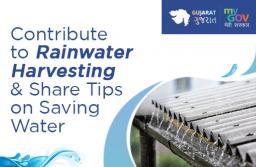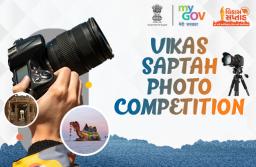The most precious gift of nature to humanity is water. Since life on earth cannot exist without it, water can also be referred to as life. We need water for all our daily activities.
The available water resources should be used judiciously, so that we do not face water crisis in future. For this, it is necessary that everyone uses water mindfully, conserves water as well as spreads awareness about water conservation measures.
By saving more and more rainwater and taking various measures to save water, we can contribute in maintaining the ground water level and maintaining the availability of water continuously.
If you have adopted any innovative and unique ways of saving water, with which we can conserve more water, share it with your thoughts in the comment box below.
Last date of submission is 6th August,2022.












BrahmDevYadav 3 years 4 महीने पहले
How do we reserve rain water and use it?
Rain Water Harvesting (RWH) is the collection and storage of rain, rather than allowing it to run off. Rainwater is collected from a roof-like surface and redirected to a tank, cistern, deep pit (well, shaft, or borehole), aquifer, or a reservoir with percolation, so that it seeps down and restores the ground water.
BrahmDevYadav 3 years 4 महीने पहले
How long can water being used to water plants be stored?
Rainwater that is being used to water plants can be stored for one week before it becomes contaminated and can not be used.
BrahmDevYadav 3 years 4 महीने पहले
Is rain water healthier than tap water?
Rainwater also contains more oxygen than tap water and this helps plants grow full and lush. Carbon dioxide is also brought down to Earth to the benefit of plants when it rains. Once carbon dioxide reaches the soil, it can help release important nutrients for the plants.
BrahmDevYadav 3 years 4 महीने पहले
How can rainwater harvesting be improved?
In order to improve the rainwater harvesting a better understanding of the hydrological cycle is mandatory. Clouds are major component of the hydrological cycle; therefore, clouds distribution is the keystone of better rainwater harvesting.
BrahmDevYadav 3 years 4 महीने पहले
What are the methods of water conservation?
1.Check your toilet for leaks.
2.Stop using your toilet as an ashtray or wastebasket.
3.Put a plastic bottle in your toilet tank.
4.Take shorter showers.
5.Install water-saving shower heads or flow restrictors.
6.Take baths.
7.Turn off the water while brushing your teeth.
8.Turn off the water while shaving.
BrahmDevYadav 3 years 4 महीने पहले
Why should we do rain water harvesting?
The use of rainwater harvesting systems allows groundwater levels to recharge, which in turn aids in enhancing urban greenery. Rainwater harvesting systems are simple to set up and operate. There is no requirement of complicated purifying systems which need to be applied to cleanse groundwater, since rainwater is pure.
BrahmDevYadav 3 years 4 महीने पहले
What is the importance of rain water harvesting?
The collected water reduces flooding and decreases soil erosion by decreasing the likelihood of run offs during periods of heavy rainfall. This is good news for our rivers, streams, oceans and lakes, as they will be less polluted over time.
BrahmDevYadav 3 years 4 महीने पहले
Why should we store rain water?
Because rainwater harvesting bypasses the centralized water system, it conserves energy. DECREASES WATER CONTAMINATION:- Captured rainwater does not cause immediate runoff. Limiting runoff helps decrease the contamination of surface water by sediments, fertilizers and pesticides in rainfall runoff.
BrahmDevYadav 3 years 4 महीने पहले
What happens when there is too much rain water?
Heavy rainfall can lead to numerous hazards, for example: flooding, including risk to human life, damage to buildings and infrastructure, and loss of crops and livestock. landslides, which can threaten human life, disrupt transport and communications, and cause damage to buildings and infrastructure.
BrahmDevYadav 3 years 4 महीने पहले
How does rain come?
Rain is liquid precipitation: water falling from the sky. Raindrops fall to Earth when clouds become saturated, or filled, with water droplets. Millions of water droplets bump into each other as they gather in a cloud. When a small water droplet bumps into a bigger one, it condenses, or combines, with the larger one.